DAM Capital, a Mumbai-based financial advisory firm, has stated that the lifting of restrictions on ethanol production from B-heavy and C-heavy molasses and sugarcane juice will help normalize production volumes for sugar companies. On Thursday, the food department removed the restrictions that had been imposed in December 2023, which were originally enacted due to rising sugar prices ahead of the Lok Sabha election.
DAM Capital believes that this clarity on ethanol blending and the full utilization of distillery capacities by sugar mills will drive significant earnings growth from Q3FY25 onwards. The firm is optimistic about the sugar industry and expects a sector re-rating, leading them to assign higher earnings multiples to the companies in their coverage.
The food department, working with the petroleum and natural gas ministry, regularly reviews the diversion of sugar for ethanol production to ensure a steady supply of sugar for domestic consumption throughout the year. DAM Capital forecasts that sugar inventory levels will exceed 8 million tonnes by October, well above the minimum requirement of 5 million tonnes. Gross sugar production is anticipated to reach 32 million tonnes, surpassing the consumption of 29 million tonnes. This surplus is expected to provide over 5 million tonnes of sugar available for ethanol production from B-heavy molasses and sugarcane juice.
DAM Capital estimates that 4-5 million tonnes of sugar could be diverted for ethanol, potentially resulting in 4.5 to 5 billion liters of ethanol production in the country.
Additionally, the food department has permitted distilleries to participate in the FCI rice auction. Distilleries can now bid for up to 23 lakh tonnes of rice, subject to compliance. This measure is expected to facilitate the resumption of the ethanol blending program for the 2024-25 season.
The government’s target to achieve 20% ethanol-blended petrol by 2024-25 and 30% by 2029-30 is expected to receive a boost from this new policy. Currently, ethanol from cane juice constitutes 25-30% of total production, while B-heavy molasses accounts for over 60-65%, with C-heavy molasses and grains making up the remainder. The introduction of E20 blending aims to reduce oil import costs, enhance energy security, lower carbon emissions, and improve air quality. The target for E20 fuel has been advanced from 2030 to 2025.
To read more about Ethanol Industry News, continue reading BioEnergyTimes.com














